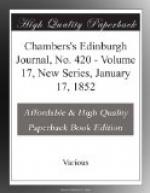upon what the price of funds will be on the next settling-day.
These transactions have been pronounced fraudulent
by the superior courts, and liabilities so contracted
cannot be legally recovered. It is, for all that,
quite certain that these ’debts of honour’
entail misery, ruin, often death, on the madmen who
habitually peril everything upon the turn of the Stock-Exchange
dice—dice loaded, too, by every fraudulent
device that the ingenuity of the two parties engaged
in the struggle can discover or invent. To the
‘Bears,’ who speculate for a fall, national
calamity is a God-send. Especially a failure
of the harvest, or a great military disaster like
that which befell the Cabool expedition, is an almost
priceless blessing—a cause of jubilant thanksgiving
and joy. The ‘Bulls,’ on the other
hand, whose gains depend upon a rise in the funds,
are ever brimful of boasts, and paint all things
couleur
de rose. If the facts bear out the assertions
of these bands of
speculators—we
prefer a mild term—why so much the better
for the facts; but if not, sham-facts will answer the
purpose, and to manufacture
them ‘is as
easy as lying.’ It is a remarkable fact,
by the way, that out of the multitude of British fundholders
there are not more than about 25,000 persons who are
liable from that source to the income-tax—that
is, who receive dividends to the amount of L.150 and
upwards annually. The most numerous class of
the national creditors eleven years ago—and
there has, we believe, been no later return—were
those whose annual dividends did not exceed L.50.
These numbered 98,946: the next largest class,
85,069, were creditors whose yearly dividends did not
exceed L.5; whilst only 192 persons were in the receipt
of annual dividends exceeding L.2000.
But leaving these haunts of money-dealers, let us
pass over to Leadenhall Street, turn down Billiter
Street, and walk on till we reach Mark Lane and the
plain, spacious, substantial, Doric-fronted building
on the left hand, in which the great London Corn Market
is held every Monday, Wednesday, and Friday—the
chief market, however, being that of Monday.
There are no clamorous shoutings here. These
crowds of staid, well-dressed, respectable people fly
no kites, deal in no flimsy paper-schemes and shares.
Their commerce is in corn, flour, seeds—the
sustenance of man, in short. There are sober
traders in realities, and the busy hum of voices has
a smack of healthy traffic in it. It would so
appear at all events, if we care not to look beneath
the surface; and, in sooth, since the abolition of
the sliding-scale has rendered the corn-supply continuous
and regular as other staples, gambling to any ruinous
extent has become almost impossible.




